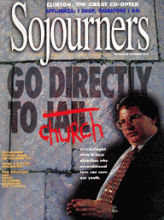Four water cannons. Two vicious dogs. Six armored personnel carriers. A score of police. I cringed as I walked past these former symbols of apartheid, making my way into the town hall in rural Ladybrand, near South Africas border with Lesotho. But inside, it was explained that the security measures were necessary, not to control the crowd, but because of bomb threats from right-wing elements angry about the truth-telling going on there.
The Truth and Reconciliation Commission hearings in Ladybrand in late June were the last in an 18-month series around the country, aimed at uncovering gross human rights violations from South Africas apartheid years. In contrast to the security apparatus outside, at the front of the hall burned a single white candle, lit at every hearing as a sign of endurance and hope.
The hall was overflowing. People had come three hours from the black township of Bethulie, packed into dilapidated vans and taxis, determined to tell their stories or support others in their telling. What stays with me is a collage of faces: confident, angry, young faces; pained old faces staring at the floor; activist faces bearing the scars of resistance. I will never forget the looks of pride, pleading, and relief.
The stories were often accompanied by tears. A social worker sat beside each witness, offering a comforting arm around the shoulder, a tissue, or a glass of water when needed. For three days the stories of anguish poured out.
Read the Full Article
